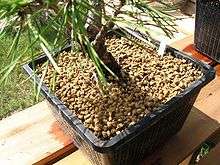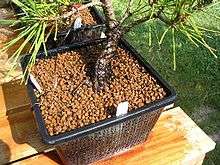Akadama


Akadama (赤玉土 akadamatsuchi, red ball earth) is a naturally occurring, granular clay-like mineral used as soil for bonsai trees and other container-grown plants. It is surface-mined, immediately sifted and bagged, and supplied in various grades: the deeper-mined grade being somewhat harder and more useful in horticulture than the more shallow-mined grades. Akadama may also act as one component of growing medium when combined with other elements such as sand, composted bark, peat, or crushed lava. Akadama’s colour darkens when moist which can help the grower determine when to water a tree.[1]
While akadama is more costly than alternative soil components, it is prized by many growers for its ability to retain water and nutrients while still providing porosity and free drainage. For all of its qualities, many bonsai growers consider the cost of akadama prohibitive or unnecessary. Still other growers claim that when subjected to cold and wet climates, the granules progressively break down into smaller particles which inhibit drainage, an essential characteristic of bonsai soil. This problem can be avoided either by incorporating sand or grit in the soil mix, or by using the deeper-mined, harder grades.[1]
A product manufactured in the United States, "Turface", which is used as a soil amendment and for surface dressing of baseball infields, is often erroneously thought to be a similar material. However, it bears no similarity to akadama.[1]
References
- 1 2 3 Lewis, Colin. "Mineral Components". Colin Lewis Bonsai Art. Retrieved 2013-06-02.